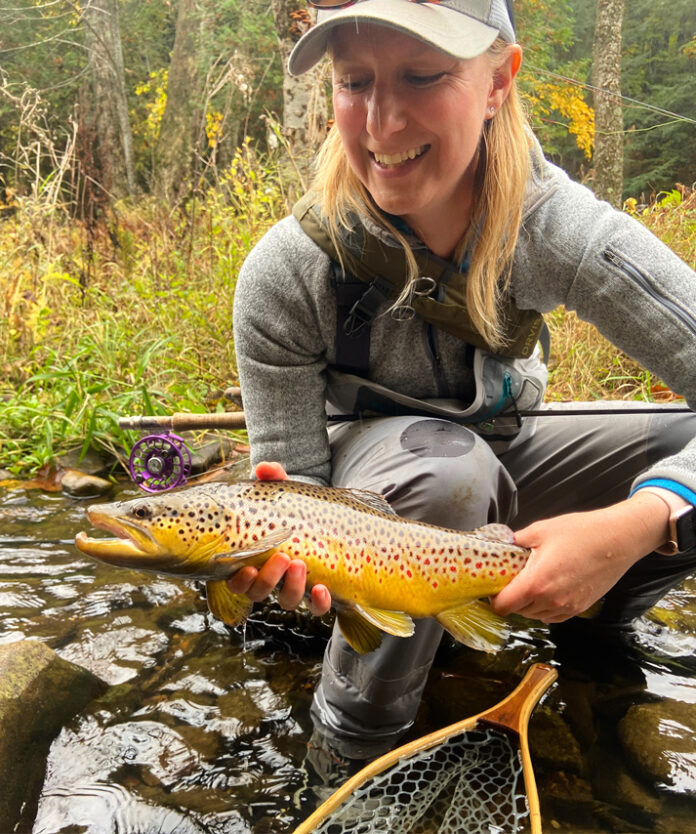Written by Erin Lyons
Most of us are self-taught anglers. A few books here, a few YouTube videos there, some trips with friends or older relatives, and you develop a grasp of the basics and then learn the rest by practice. This works just fine, and I’ve had four years of fun in the sport with my patchwork proficiency. But I’ve also developed some bad habits. And I was embarrassed that I still couldn’t cast cleanly over 30 feet or get rid of that pesky tailing loop. So I enrolled in Orvis’s 2-Day School in Manchester, Vermont, to get straightened out. . . literally.
The course description said that I would learn the Orvis Progressive Method of Casting, from the basic overhead cast all the way to the double-haul. The idea of learning a true method of casting appealed mightily to me. I have never had a method—only several gurus’ voices in my head: Joan Wulff, Lefty Kreh, Macauley Lord, and others. And they sometimes said conflicting things: no wrist/all wrist, no force/more force, watch the rod/watch the target. I have always been an good student, and I was craving answers, structure, and discipline. With proper training, I knew I could become a lean, mean casting machine.
Aside from personalized casting instruction, I was also looking forward to filling in a few knowledge gaps with the lessons on gear, tackle, fly selection, entomology, and knot-tying. You can get all of this in the 1-Day School. I chose the 2-Day School for two reasons. One, they videotape your cast and then play it back for you to show what your particular challenges are. Second, you get time on the water with the instructors.

When I arrived, I was relieved to find that I wasn’t the only woman there (there were five) and that I wasn’t the only solo student. Levels of experience ranged from total novice to lifelong anglers. There were married couples, a former game warden, gal pals from New York City, and people who had traveled three-plus hours just for the school.
After a brief breakdown of the casting method by three phenomenal instructors, we immediately got to practicing on the Orvis Flagship Store’s casting pond. It was not a bootcamp; there were no drill sergeants; I did not have to hold a book under my arm. Each of the instructors came around to offer gentle help and each had their own patient way of explaining the technique—and their own ingenious metaphors. I learned how a forward cast is like throwing a frisbee, painting like Jackson Pollock, snapping a wet towel at someone, and my favorite of all: flicking a flaming marshmallow off a stick at your sibling.
One law of the universe is that your cast will completely suck as soon as someone starts watching it, and never was that more true. Especially when they videotaped us. Yet, as promised, I improved. At the very end of the first day, I found a groove. The rhythm that finally clicked was entirely different from what I’d been doing for five years. It was much slower and more relaxed. And lo, I finally made a tight loop.

I was so excited that I went home and practiced for two more hours. I was shooting line like a pro; I was hitting my target like Annie Oakley; I was loading that rod and throwing that loop like bibbity-bobbity-boo. But when I went back to school the next morning, it had all deserted me. I was crestfallen.
Truel Myers, the Jedi master of casting instructors, seemed unfazed by my report. (It was almost as if he’d seen this before!) He replayed my video for me from the previous day. I was dreading this, convinced I was a mess, but what I saw surprised me: I was not nearly as awful as I’d imagined. He pointed out what I was doing well and praised my pick-up and back cast. Then he paused the video at the precise moment I began my forward cast, and I saw immediately what was wrong. I was rushing it. He put the video in slow motion and traced my loop with his laser pointer. I saw where the leader whipped under before getting a chance to unfurl. I saw my head turn toward the target and away from my line instead of watching it fully extend. It was a definite aha! moment.
I couldn’t wait to cast again. As a class, we caravan-ed down to the bank of the storied Battenkill, donned our waders, and rigged up. I saw everything with new eyes, after all that I’d learned in the lectures: the physics of the clinch knot, the mathematics of tippet selection, the micro-climate considerations when choosing my fly. As we began to spread out on the river, I trembled with anticipation. I strode into the water, armed with new confidence and knowledge. I had leveled up and straightened out.

I caught a tree in the first cast. But by the fourth or fifth cast, and a few more encouraging words from Truel, I remembered to relax and slow down. A better cast wasn’t about learning discipline or straightening out. It was about what fishing is always about: unwinding.
To learn more about Orvis Fly Fishing schools around the country, click here.
Erin Lyons is a marketing strategist and the president of the Southwestern Vermont chapter of Trout Unlimited. She lives in East Arlington, Vermont.
Credit: Source link






























